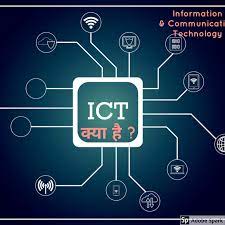04 Aug 2022 ICT Tools & Digital Intervals

- Recently the Education Minister informed the Lok Sabha that less than 10% of schools in at least 10 states of India are equipped with Information and Communication Technology (ICT) equipment or digital equipment.
ICT Equipment:
- ICT tools for teaching and learning range from digital infrastructure like printers, computers, laptops, tablets etc. to software tools like Google Meet, Google Spreadsheet etc.
- It refers to all communication technologies that are tools to access, retrieve, store, transmit and modify information digitally.
- ICT is also used to refer to the convergence of telephone networks with media technologies such as audio-visual and computer networks through an integrated system of cabling (including signal distribution and management) or link systems.
- Although given that the concepts, methods and tools involved in ICT are constantly evolving on an almost daily basis, there is no universally accepted definition of ICT.
Digital Interval:
- It is the difference between demographics and areas with and without access to modern information and communication technology (ICT).
- It exists between developed and developing countries, urban and rural populations, young and educated versus older and less educated individuals, men and women.
- The urban-rural divide is the biggest factor in the digital gap in India.
Situation:
- A study conducted by the Azim Premji Foundation in 2021 showed that almost 60% of school children in India cannot access online learning opportunities.
- An Oxfam India study found that parents of students from urban private schools reported problems with internet signal and speed.
Influence:
Reasons for Dropout and Child Labour:
- Children belonging to the ‘Economically Weaker Sections’ [EWS]/Deprived Groups [DG] are facing the consequences of not completing their education, as well as the lack of access to the Internet and computers in the meantime.
- Those children have also become vulnerable to child labor or child trafficking.
Lack of quality education:
- It will deprive people of high/quality education and skill training which can help them to contribute to the economy and be a guiding leader at the global level.
Fostering unfair competition:
- They will remain deprived of important information submitted online regarding education and thus they will always be left behind, which can be expressed in the form of poor performance.
- Thus fostering unfair competition between students who are able to access the Internet and those who are less privileged.
Learning Inequality:
- People from lower socio-economic classes are disadvantaged and they have to go through long hours of cumbersome study to fulfill the objectives of the course.
- Whereas the rich can easily access schooling material online and work on their programs instantly.
Constitutional Provision for Right to Education
- Article 45 and Article 39 (f) of Part-IV (Directive Principles of State Policy -DPSP) of the original Indian Constitution made provision for equal and accessible education funded by the state.
- Right to education was included as a fundamental right in Part-III of the Constitution by the 86th Constitutional Amendment in the year 2002.
- It was included under Article 21A, which made the right to education for 6-14 year olds a fundamental right.
- It provided for a follow-up law, the Right to Education Act, 2009.
YojnaIAS daily current affairs eng med 4th August (1)


No Comments